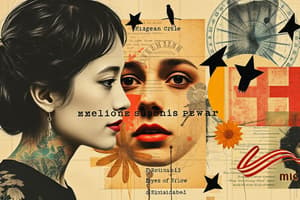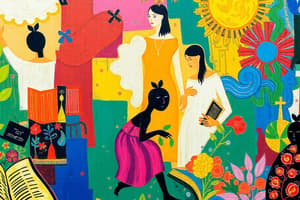Podcast
Questions and Answers
Study Notes
Literature Overview
- Literature serves as a unique medium to convey ideas and emotions.
- Provides insights into diverse perspectives and experiences, enhancing our understanding of the world.
- Reading literature fosters connections with others and broadens knowledge about their lives.
- Reflects the culture and values of its time, not merely a random collection of texts.
Timeline of Philippine Literature
Pre-Colonial Period
- Characterized by rich traditions, complex societal structures, and distinct religious beliefs.
- Societal organization was based on barangays, small communities governed by a datu (chief).
- Education was informal, relying on imitation and practical learning rather than structured methods.
- Prominent in this era was oral literature, which included diverse forms.
Forms of Literature
- Epic: Long narrative poems recounting the deeds of heroic figures.
- Legends: Traditional stories that explain the origins of natural phenomena or cultural practices.
- Riddles: Puzzles that stimulate critical thinking and creativity.
- Proverbs: Short, commonly known sayings that convey wisdom and insights.
Common Themes and Genres
- Literature often explores moral tales, reflecting ethical lessons and values.
- Emphasizes community, celebrating social ties and collective identity.
- Highlights pre-colonial culture and traditions, preserving heritage and history.
Notable Writers
- Oral literature was passed down through generations, with narratives told and retold by the natives, preserving their stories and cultural identity.
Spanish Period
- Initiated with territorial expansion and evangelization, symbolized by the Sword and the Cross.
- Utilized the Roman alphabet; bilingual literary medium with works in Spanish and Tagalog.
- Literature content displayed a bicultural character, blending indigenous and Spanish influences.
- Introduction of the first printing press enabled the publication and dissemination of written works.
- Forms of literature included:
- Corrido
- Awit
- Zazuela
- Duplo
- Moro-moro
- Common themes encompassed faith, nationalism, love, and social issues.
Nationalistic Period
- Characterized by a strong sense of national identity and pride among Filipinos.
- Tagalog emerged as the primary language for literary expression.
- Education became more accessible to the broader Filipino populace, moving beyond the elite "intelligentsia."
- Forms of literature developed during this period included:
- Propaganda Literature
- Revolutionary Literature
- Common themes focused on patriotism, social justice, and resistance against colonial oppression.
- Notable writers included:
- Dr. Jose P. Rizal
- Graciano Lopez Jaena
- Marcelo H. Del Pilar
- Andres Bonifacio
- Emilio Jacinto
American Period
- Marked the introduction of the English language and new literary styles in the Philippines.
- Reformed education system made English the medium of instruction, creating greater educational opportunities.
- Americans provided free education, enabling Filipinos to learn English.
- Filipino writers often imitated American writing styles, adapting them to local contexts.
- Forms of literature prominent during this era included poetry, short stories, and novels.
- Common themes explored identity, freedom, and local color, reflecting Filipino experiences under American colonial rule.
Studying That Suits You
Use AI to generate personalized quizzes and flashcards to suit your learning preferences.
Description
Explore the rich traditions and cultural values of Philippine literature from the pre-colonial period to the present. This quiz highlights how literature reflects societal structures and diverse perspectives throughout history. Test your knowledge of significant literary movements and their impact on the culture.




